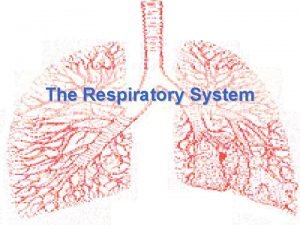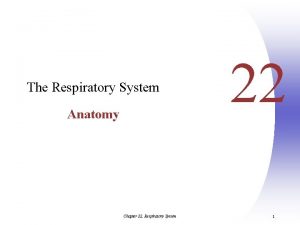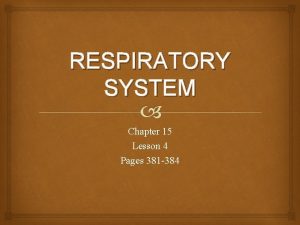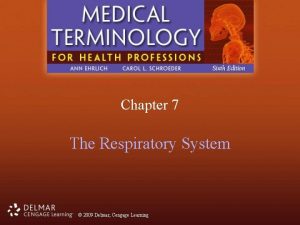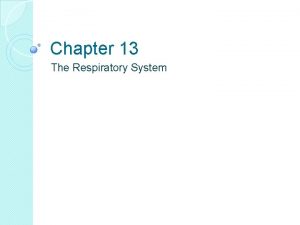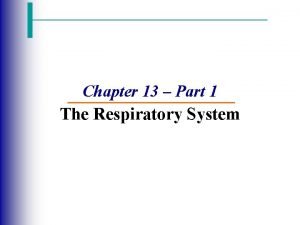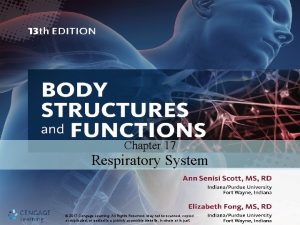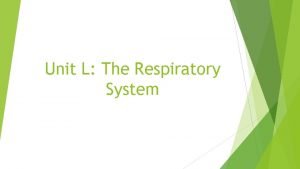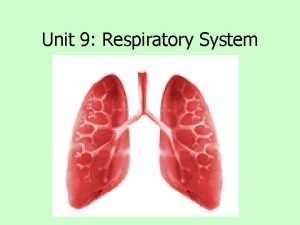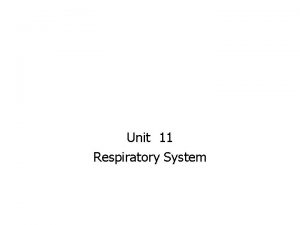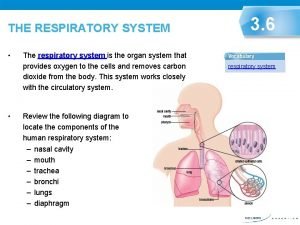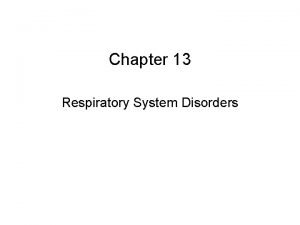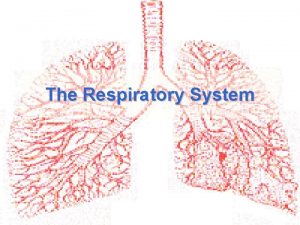The Respiratory System Chapter 11 Purpose The purpose


















- Slides: 18

The Respiratory System Chapter 11

Purpose • The purpose of the Respiratory System is to provide oxygen for the cells and to remove excess carbon dioxide from the cells. • The reason cells need oxygen and have excess carbon dioxide is that they are constantly performing aerobic respiration, which uses up oxygen and produces carbon dioxide. • The respiratory system is named after aerobic respiration, the process that it supports.

1. Nostril/Mouth 2. Pharynx 3. Larynx 4. Trachea 5. Bronchi 6. Bronchioles 7. Alvioli 8. Bronchioles 9. Bronchi 10. Trachea 11. Larynx 12. Pharynx 13. Nostril/Mouth Pathway

1 - Nostril/Mouth • Air begins its journey in the nostrils or the mouth. • The main difference between the nose and the mouth is that the nostrils contain many hairs and mucus. • The function of these is to trap bacteria, dust and other particles and prevent them from reaching the sensitive lungs. • The hairs and mucus serve to filter and warm the air before it reaches the lungs.

2 - Pharynx • Whether you breathe through the mouth or through the nose, the passageways merge in the pharynx. • When breathing, the epiglottis is up, allowing passage of the air into the Larynx.

3 - Larynx • The larynx is the technical term for the voice box. • The larynx is two membranes that are stretched over the trachea. • When air is breathed out, the membranes vibrate, producing sound, which humans can control. • This is why you cannot speak while breathing in, only while breathing out.

4 - Trachea • The trachea is the widest airway in the respiratory system. (the “aorta” of the respiratory system) • It is around 5 inches long and one inch wide.

4 - Trachea • The trachea is lined with a ciliated mucus membrane. • This means that its walls are lined with tiny cilia, which resemble villi, that catch foreign particles and prevent them from entering the lungs. The cilia then move the foreign particles up the trachea and out to the pharynx and are then swallowed.

Phlegm • The trachea also contains mucus, called phlegm that causes bacteria and dust to get stuck to it and not enter the lungs. • When a person coughs up phlegm, the mucus is brought up to the pharynx and swallowed back down the food pipe, the esophagus. • Sometimes, a person can get an infection in the trachea, which will cause the body to produce excess phlegm.

5 - Bronchi • After the trachea, the air splits into two passageways, known as the bronchi. (The “arteries” of the respiratory system).

6 - Bronchioles • The bronchi then split into smaller tubes, called bronchioles (like arterioles). • As the tubes get smaller and smaller, the walls of the tubes are made of thinner and thinner cartilage. • The bronchi and bronchioles also are lined with cilia and mucus.

7 - Alveoli • These bronchioles then split into smaller and smaller tubes until they end in a cluster of sacs that appear like a bunch of grapes. • These are called alveoli. • The walls of the alveoli are only one cell thick. (Like the capillaries of the respiratory system)

7 - Alveoli • Each alveolus is surrounded by capillaries. This is where gas exchange occurs between the lungs and the blood. • The capillaries give carbon dioxide to the alveoli and the alveoli give oxygen to the blood.

7 - Alveoli • One of the reasons that gas exchange in the alveoli is so efficient is that there are roughly 300 million alveoli, taking up 40 times the surface area of your body! • This is why the breathing process is so rapid – the oxygen accomplishes its purpose very rapidly because it has so much surface area.

Inhalation • Until this point, we have discussed how the air travels from outside the body. • This process is called inhalation (breathing in). • Inhalation is accomplished by pushing the rib cage out and by pulling the diaphragm down. • This creates more space in the lungs, causing air to rush in from the outside.

Exhalation • Exhalation is the process of breathing out. This is accomplished by the rib cage contracting and the diaphragm relaxing. • This causes air to rush out of the lungs.

Steps 8, 9, 10, 11, 12, 13 • • • 8 - Bronchioles 9 - Bronchi 10 - Trachea 11 - Larynx 12 - Pharynx 13 - Mouth/Nostrils • Steps 1 -7 are part of inhalation. • Steps 7 -13 are part of exhalation.

Inhaled air vs Exhaled air Gas % in inhaled air % in exhaled air Oxygen 21 16 Carbon Dioxide 0. 4 4 Where does the extra carbon dioxide come from? Where does the oxygen go? From the cells doing aerobic respiration. To the cells to perform aerobic respiration.
 Conducting zone of the respiratory system function
Conducting zone of the respiratory system function Digestive system respiratory system and circulatory system
Digestive system respiratory system and circulatory system Respiratory system purpose
Respiratory system purpose How respiratory system work with circulatory system
How respiratory system work with circulatory system Circulatory system and respiratory system work together
Circulatory system and respiratory system work together Chapter 7 cengage
Chapter 7 cengage Chapter 13 the respiratory system
Chapter 13 the respiratory system Perfusion respiratory system
Perfusion respiratory system The parts of the respiratory system in order
The parts of the respiratory system in order Chapter 7 the respiratory system labeling exercises
Chapter 7 the respiratory system labeling exercises Chapter 34 section 1 the circulatory system
Chapter 34 section 1 the circulatory system Respiratory system organs
Respiratory system organs Chapter 13 respiratory system worksheet
Chapter 13 respiratory system worksheet Chapter 17 respiratory system workbook answers
Chapter 17 respiratory system workbook answers Respiratory system bozeman
Respiratory system bozeman Unit 9 respiratory system
Unit 9 respiratory system Diagnostic test of respiratory system
Diagnostic test of respiratory system Respiratory system
Respiratory system Membranes and ligaments of larynx
Membranes and ligaments of larynx


